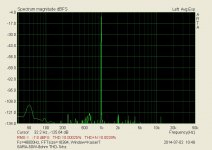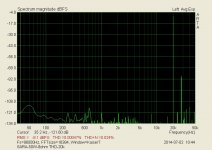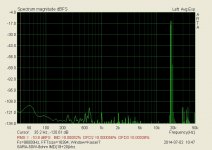Member
Joined 2009
Paid Member
A simple triode SET sounds very good too and it's distortion will be a lot higher than even a push-pull VAS. I think what Doug is saying - why use a push-pull VAS when a single VAS can be better ?
My latest amp (TGM8) uses a single VAS and to a large extent the approach would be consistent with advice I've seen in some of Doug's earlier editions. For my ears I'm not sure I know how to make a better sounding amp - I certainly don't see a push-pull VAS being a natural next step.
My latest amp (TGM8) uses a single VAS and to a large extent the approach would be consistent with advice I've seen in some of Doug's earlier editions. For my ears I'm not sure I know how to make a better sounding amp - I certainly don't see a push-pull VAS being a natural next step.
Last edited:
I'm not sure I know how to make a better sounding amp
A famous designer like Mr. Curl may teach you that 😀.
of course sighted listening with the "story" of how your circuit, tweaks "work" firmly in mind while looking at your creation, comparing "by memory" from days/weeks ago...
beats psychoacoustic controlled blind listening tests for convincing yourself of "better sound"
beats psychoacoustic controlled blind listening tests for convincing yourself of "better sound"
Member
Joined 2009
Paid Member
A famous designer like Mr. Curl may teach you that 😀.
I was hoping to learn from you, since you are nobody 😀
(I thought you accepted that moniker with a lot of grace !)
Member
Joined 2009
Paid Member
Learning? 😉
Learning aside, I don't believe there's enough scope for improvement with SS Class AB technology and currently available parts to warrant any further investment of my time and effort trying to better the sound of my TGM7 and TGM8. I'm sure there are better amplifiers out there (by somebodys definition of 'better') but it's now a case of diminishing returns and all that... and life is too short.
Learning aside, I don't believe there's enough scope for improvement with SS Class AB technology and currently available parts to warrant any further investment of my time and effort trying to better the sound of my TGM7 and TGM8. I'm sure there are better amplifiers out there (by somebodys definition of 'better') but it's now a case of diminishing returns and all that... and life is too short.
I used to think like this briefly, but diminishing returns or not its all a return and something that keeps Audio alive in search of a possibly better sound. Things really got moving over here when I got a pair of electrostatics 🙂
Colin
Member
Joined 2009
Paid Member
I find my interest now is in playing with some ideas just for the fun, not necessarily because I expect better sound but just to find out what will happen... 🙂
The fact of the matter is complementary diff input push pull VAS are found in some of the best measuring and selling high end amplifiers in the industry - and that's been the case for 20 or more years, maybe longer.
There are many ways to design an amplifier, and lots of tradeoffs are involved. I just cannot believe that for class AB SS has you gravitate towards the blameless topology before it qualifies as 'best'. While it has been a great vehicle for dispelling some of the subjective bs around amplifier design, it is still deeply flawed beyond a certain point.
Non symmetrical slew rate
Non symmetrical drive to OPS almost always necessitating an EF3 if you want to preserve loop gain
You have to use low input tail currents if you have any chance of DC coupling, and that drives compensation compromises in my view.
Complementary diff balanced push pull VAS (I just call it fully balanced symmetrical or FBS) suffer from none of these issues, although this does come at the expense of a little more complexity in the small signal stages.
As instated in my e-Amp write-up, if I were to design a high volume consumer amp, I'd probably go for a blameless for cost reasons, capacitively coupled input etc. tried and tested and so forth, but above all, cheapest to make. But, this is DIY and I am not constrained by cost considerations.
There are many ways to design an amplifier, and lots of tradeoffs are involved. I just cannot believe that for class AB SS has you gravitate towards the blameless topology before it qualifies as 'best'. While it has been a great vehicle for dispelling some of the subjective bs around amplifier design, it is still deeply flawed beyond a certain point.
Non symmetrical slew rate
Non symmetrical drive to OPS almost always necessitating an EF3 if you want to preserve loop gain
You have to use low input tail currents if you have any chance of DC coupling, and that drives compensation compromises in my view.
Complementary diff balanced push pull VAS (I just call it fully balanced symmetrical or FBS) suffer from none of these issues, although this does come at the expense of a little more complexity in the small signal stages.
As instated in my e-Amp write-up, if I were to design a high volume consumer amp, I'd probably go for a blameless for cost reasons, capacitively coupled input etc. tried and tested and so forth, but above all, cheapest to make. But, this is DIY and I am not constrained by cost considerations.
Fair enough Bigun,
If your anything like me the fun only lasts so long until you get that thirst again to try and build a better "sounding" mousetrap. I guess my experience from going from the blameless topologies to current feedback /diamond structure is the same as going from dynamic drivers to esl's. Granted the design as current was built to drive highly capacitive loads without having any effect on the vas and feedback loop stability, while maintaining non switching class a without the heat.
Colin
If your anything like me the fun only lasts so long until you get that thirst again to try and build a better "sounding" mousetrap. I guess my experience from going from the blameless topologies to current feedback /diamond structure is the same as going from dynamic drivers to esl's. Granted the design as current was built to drive highly capacitive loads without having any effect on the vas and feedback loop stability, while maintaining non switching class a without the heat.
Colin
Cordell and Groner (in his "comments", Figure 59, Page 48) propose a push-pull VAS à la Hitachi with a common mode loop to balance the currents in the input stage. This common mode loop seems to be a very old technique used in some integrated op-amps.
Somewhat confused here as in my copy of Samuel Groner's most excellent commentary, Figure 59 is on p51 and shows an output stage. Do you mean Figure 57 on p49?
Common-mode feedback was certainly used in some early opamps (we're talking pre-741 here) but as I understand it the aim was to increase common-mode rejection rather than balance the input Ic's. CMRR in early opamps was unimpressive, and I think tackling this took priority over distortion issues.
Somewhat confused here as in my copy of Samuel Groner's most excellent commentary, Figure 59 is on p51 and shows an output stage. Do you mean Figure 57 on p49?
Common-mode feedback was certainly used in some early opamps (we're talking pre-741 here) but as I understand it the aim was to increase common-mode rejection rather than balance the input Ic's. CMRR in early opamps was unimpressive, and I think tackling this took priority over distortion issues.
Some fully differential designs have undefined common mode levels/currents and a common mode loop is required. Many of these circuits require some sort of exact area ratios and/or matching so they are not easy or even doable in discrete design. Most of the xDSL drivers, for instance, were fully differential throughout.
Somewhat confused here as in my copy of Samuel Groner's most excellent commentary, Figure 59 is on p51 and shows an output stage. Do you mean Figure 57 on p49?
Common-mode feedback was certainly used in some early opamps (we're talking pre-741 here) but as I understand it the aim was to increase common-mode rejection rather than balance the input Ic's. CMRR in early opamps was unimpressive, and I think tackling this took priority over distortion issues.
Sorry, my fault.
I mean Figure 56 page 48.
The voltage at the output CCS I2 / emitters of Q7-Q8 (which belong to the VAS) is used to drive the active collector loads of the input pair.
I think some examples here would be useful. Can you name some of these designs and give us the performance figures? A target to beat is the Blameless/Inclusive amplifier whose plot is shown in Figure 12.14 of APAD6. I'll post a copy of that once I can get hold of the file.The fact of the matter is complementary diff input push pull VAS are found in some of the best measuring and selling high end amplifiers in the industry - and that's been the case for 20 or more years, maybe longer.
What tradeoffs do you think exist for the Blameless amplifier? I don't think I'm aware of any serious ones.There are many ways to design an amplifier, and lots of tradeoffs are involved.
I just cannot believe that for class AB SS has you gravitate towards the blameless topology before it qualifies as 'best'. While it has been a great vehicle for dispelling some of the subjective bs around amplifier design, it is still deeply flawed beyond a certain point:
Non symmetrical slew rate. Non symmetrical drive to OPS almost always necessitating an EF3 if you want to preserve loop gain
As noted upthread, an asymmetrical slew limit is actually a good thing to have. Shortage of loop gain is not an issue with the Blameless configuration, but it certainly is with the common push-pull VAS configurations. See APAD6 Figure 8.15, where the push-pull VAS has 40 dB less o/l gain at low frequencies. You seem to have this backwards.
Not understood at all. Are you talking about DC coupling the amplifier output?You have to use low input tail currents if you have any chance of DC coupling, and that drives compensation compromises in my view.
This is just not true. APAD6 Chapter 8 is a litany of woe incurred as soon as you go to a push-pull VAS. There are all kinds of problems, from which the Blameless configuration is blessedly free.Complementary diff balanced push pull VAS (I just call it fully balanced symmetrical or FBS) suffer from none of these issues, although this does come at the expense of a little more complexity in the small signal stages.
As I said before, I would be very happy if more (apparently) sophisticated circuitry gave better results. But it does doesn't.
If you want to move on from the Blameless/Inclusive configuration, Samuel Groner's push-pull design in Linear Audio Volume 2 is well worth pursuing. I will evaluate it myself when I get time. Right now I'm designing a power amplifier...
Hello Douglas,
Do you have any transformer coupled amplifiers in your books ?
.
Yes, in the last chapter on the history of amplifiers.
Member
Joined 2009
Paid Member
Fair enough Bigun,
If your anything like me the fun only lasts so long until you get that thirst again to try and build ...... maintaining non switching class a without the heat.
Colin
You may be right!
Well, perhaps your OPS could trigger something - are you willing to reveal it or do you want us to make our best guess 🙂 ?
Last edited:
We are on different planets on the subject of amplifier design and perhaps that is a good thing. Though it's a pity you seem unable to consider other topologies and talk about them in an open and constructive way - it's all a bit one dimensional - blameless and lowest distortion, despite the fact that you cannot here any differences below about 0.1% and speakers much higher.
For very low distortion balanced designs, see Parasound, the big Marantz's etc. and for AP plots go to Stereophile where in reviews, more often than not, the topology is stated - but you probably know that anyway.
For very low distortion balanced designs, see Parasound, the big Marantz's etc. and for AP plots go to Stereophile where in reviews, more often than not, the topology is stated - but you probably know that anyway.
Last edited:
SARA amplifier , my design, push-pull VAS. 2x100W in 8 ohm
The 20kHz THD measurement has some problem - what does produce the ~ -80dB signal around 30kHz?
- Status
- Not open for further replies.
- Home
- Amplifiers
- Solid State
- Your opinions are sought on Audio Power Amplifier Design: 6th Edition. Douglas Self


